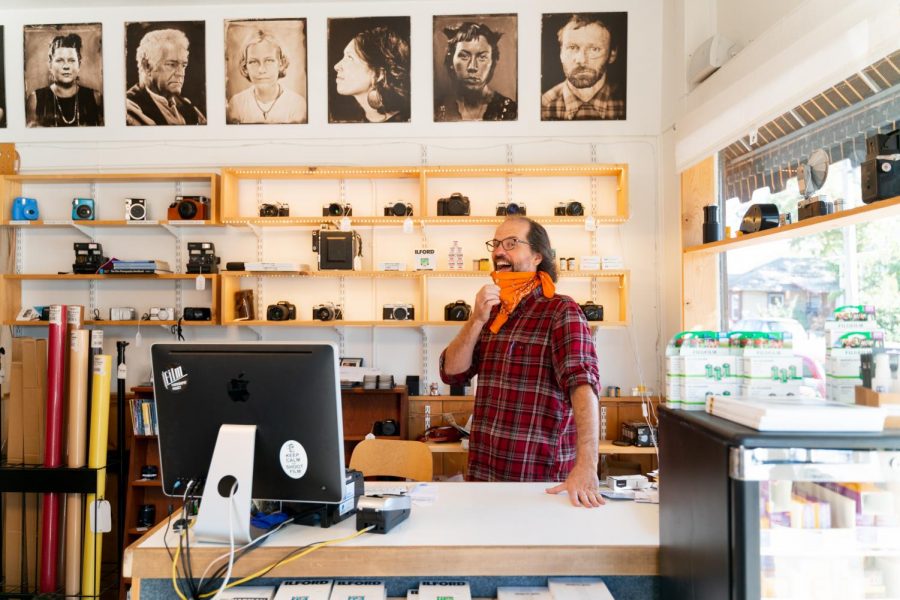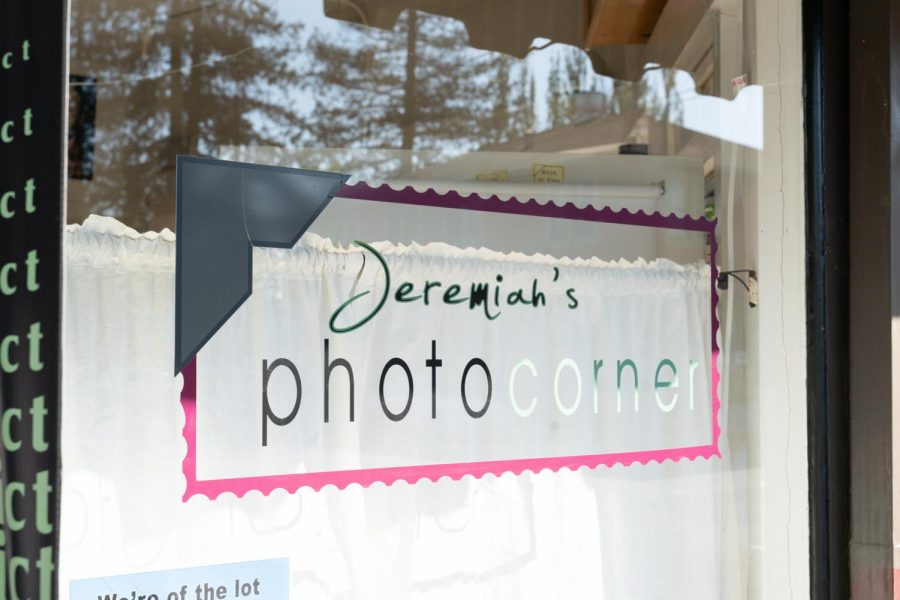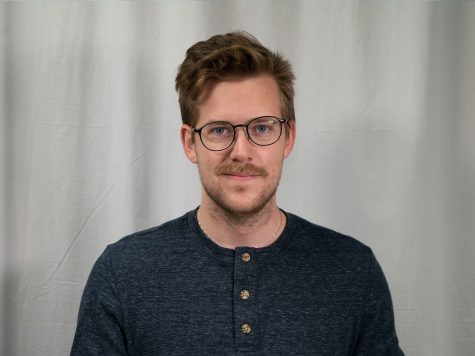Megapixels, HDR, dynamic range and 4K recording; these are the must haves of digital cameras today. Imaging technology has seen leaps and bounds in the past two decades, and modern digital cameras are capable of feats unimaginable in the heydays of film photography. So why, after all of these advancements, is analog film photography seeing such a huge resurgence?
Local artist and business owner Jeremiah Flynn has seen the rise, fall and resurrection of analog photography, all while operating the only specialty film photography shop in Sonoma County. His quaint corner shop on Sebastopol Avenue in Santa Rosa is stocked with cameras from the 1930s to the early 2000s, most of them in beautiful condition. Any community member can walk in and out moments later with a 35mm camera loaded and ready to shoot.
Flynn opened his shop in 2009, and in the 11 years since he has seen his fair share of struggles. Film was on the decline in the late 2000s, and opening a business around what was quickly becoming a niche was risky. Flynn credits the Santa Rosa Junior College for maintaining him through the early years.
“Really it was based on the schools. If the schools had not kept teaching at least a hybrid film/digital photography program that would have been very hard to open and be able to make any money,” Flynn said.
The strength of running a specialty store is customer support. Flynn says that nearly 70% of all of his customers repeat, and seeing the same faces has become a hallmark of his business.
“The good part about it is that your customers are very loyal,” he said. “If you lose one, it kinda sucks, because you really have to go out and find someone and you have to convince them to start shooting film.”
Thankfully, the internet is doing most of the convincing for Flynn. With so many online creative communities, it is no surprise many became dedicated to the not-quite-so-long-lost art of analog photography.
Between YouTubers like Willem Verbeeck, Joe Greer, and Jason Kummerfeldt; and popular film-dedicated Instagram feature pages like @goldmoony, @leicalosers, and @filmdiscovered, film is seeing a revival, especially among young photographers.
So what’s drawing the young crowd back into a dated medium? Many of these young artists follow the same pattern; they become interested in photography through one way or the other, they come across these feature pages and communities that don’t look like most of the photos they see on social media, they pick up a film camera, shoot a roll of film and fall in love with the process.
Places like Jeremiah’s Photo Corner, that have persevered through the supposed death of film are an integral part of its revival, and they are seeing more and more young people coming in to get started.
“They’re going into their parents closet and they’re like, ’I’ve got this camera, I don’t know anything about it, what do I do with it?’ So we put batteries in and check it out and make sure it’s doing okay and give them a roll of film and send them on their way and they come back and get their pictures and they’re like, ‘Oh my god!’ and then they’re hooked,” said Flynn.
It’s not just young people either; Flynn credits Sonoma County’s diversity with his business’s perseverance.
“That’s the beauty of it, you get old people, you get young people, you get punks, you get fancy people, you get nerds, you get all of them,” he said. “People come to photography because they like photo and they like gear and whatever, it doesn’t matter. They get funneled in and it’s beautiful.”
Flynn has also seen how film photography can bridge gaps left between generations.
“It was always the coolest thing when you see a teenage daughter who has blue hair and a nose piercing and her CPA straight edge dad coming in with his old nikkormat, and he says, ‘Well my daughter here, Julie, is interested in photography and this is my old camera that I bought in New York in 1972,’ and then you can see, wow, this is a thing that they can bond about. It crosses generations,” he said.
As any good artist or hipster knows, there’s never a niche without a community. Flynn’s shop is a hotspot for people from all walks of life to come together and share a love for film photography.
“My sister used to say it when we were going through our lives, and she said, ‘You find people who have similar uncommon interests, and when you find those people that bond is usually a lot stronger because, even if it’s unspoken, you feel like that person knows you,” Flynn said.
Before the pandemic, you could see this on any given weekend if you stuck around Flynn’s shop for fifteen minutes. Customers would come in just to get a chance to talk shop with Flynn and when he wasn’t around, total strangers would strike up conversations like old friends. “It’s just a weird mixed bag, but the nice thing is that that common interest can bring everyone together,” he said.
Flynn isn’t just a small business owner either; he’s a photographer himself. Above the register in his shop are huge, beautiful sepia-toned portraits of friends and customers of all ages and identities.
These are the result of Flynn’s specialization in tin-type photography, a process that predates even celluloid film. Instead of a digital censor or a layer of celluloid, photosensitive chemicals are suspended onto a thin layer of metal. The process Flynn utilizes, known as wet-plate, is incredibly time sensitive. The plate has to be created only a short time before the photograph is taken, and developed immediately. This creates an instant result, and no one but a master can time the development process properly to create the stunning portraits that adorn Flynn’s shop.
Flynn is one of only a couple photographers left in the state who provide tin-type portraits as a service, and while business has lulls, he is seeing a definitive uptick in clientele.
“There’s a physicality to the whole process and people are realizing, ‘Oh, that’s good!’ and you get a tangible instantaneous results and instant gratification and a final piece,” Flynn said. “You do a lot of preparation and the final piece is made. I think it resonates with people nowadays because we don’t have a lot of crafty things.”
The subjects are also heavily involved in the process; something like the presence of a beard, skin tone or a certain shade or texture of hair will completely change the way that the artist will create the photograph. Creating portraits so specific to the subject is a huge part of the attraction to tin-types. “You feel like you’re contributing to your own final piece in a couple different ways, so it feels like you own it, and I like that,” he said.
With interest rising, even throughout the pandemic, Flynn believes that film photography could persevere.
“I could see it sticking around, cause you know, image making is always one of those things where you’re personally doing it. You’re saying, ‘This is worth taking a picture of,’ and we don’t have a lot of that these days,” he said. “I take pictures of people, and once in a while they’re casual snapshots, but usually it’s like, ‘Oh, I want to capture this. Not just this person, but the emotion I’m feeling towards the person.’”
It’s obvious that there’s a kind of magic to analog photography in the digital age. As more people discover and rediscover film, Jeremiah’s Photo Corner will be right on the corner of Sebastopol Avenue, providing film and community to hipsters, punks, nerds, students, CPA dads and anybody else who comes across their grandma’s old 35mm camera.






Jennifer Klein • Nov 20, 2020 at 9:58 am
Nicely written article and tribute to a special Sonoma County business! Best wishes to the author and Jeremiah’s Photo Corner!